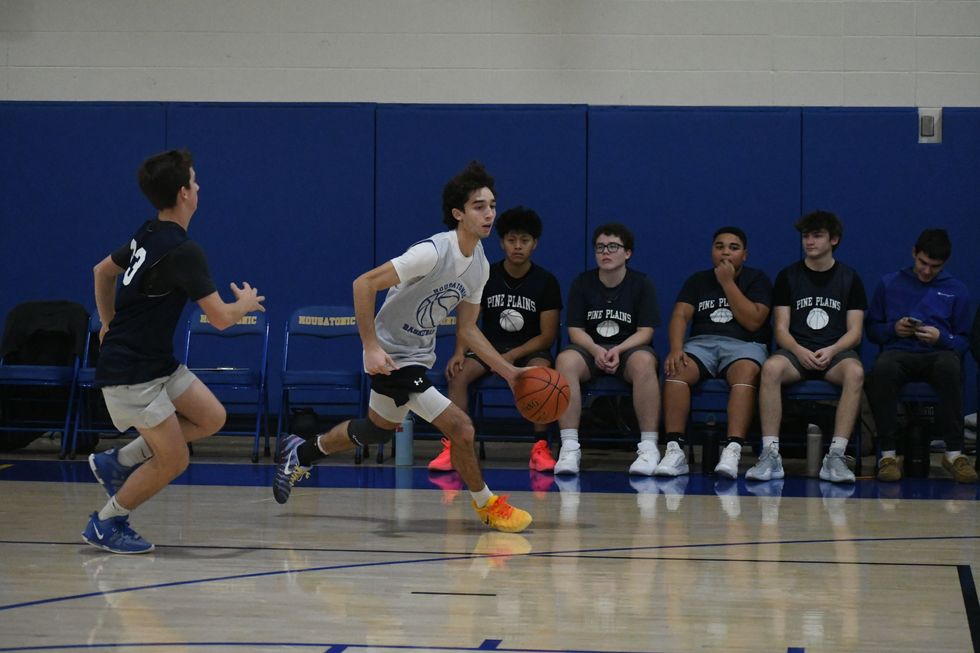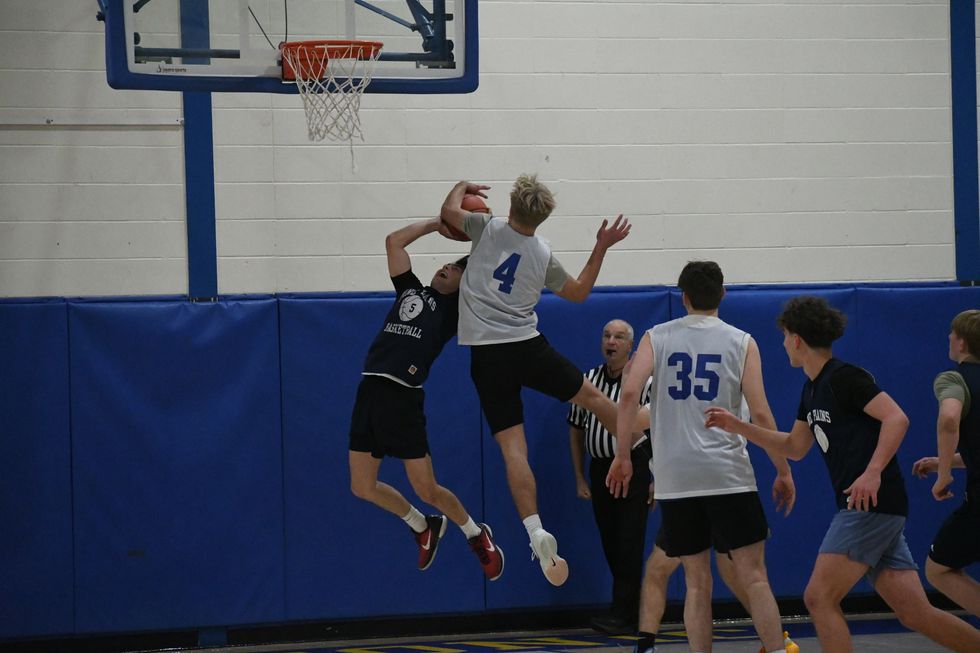Nostalgia reigns at Sharon reunion
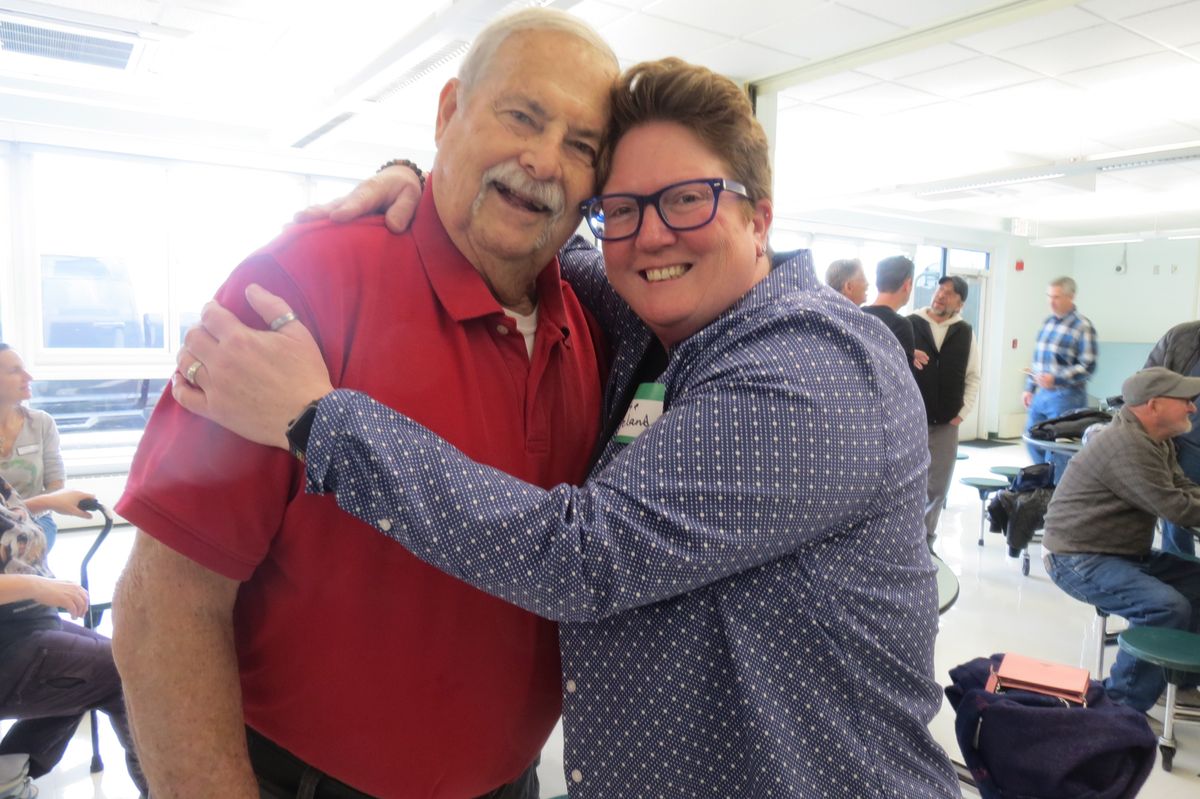
Jack Comporesi is hugged by former student Janette Ireland of Kent during the Sharon Center School reunion Saturday.
Ruth Epstein

Jack Comporesi is hugged by former student Janette Ireland of Kent during the Sharon Center School reunion Saturday.
SHARON — Memories filled the air of the Sharon Center School cafeteria Saturday, March 1, as alumni from the 1970s to 2000s gathered at the invitation from beloved teachers Irv Robbins and Jack Comporesi.
Shrieks of recognition from those who hadn’t seen each other in decades were constant. So was the laughter as reminiscences were shared. The two teachers looked on with delight, watching as the more than 100 came together.
Looking back on their years with great fondness, the pair decided to host the reunion in hopes of reconnecting with the students they so enjoyed. Robbins taught social studies and math, while also coaching and Comporesi, affectionately known as “Compo,” was the physical education teacher and coach.
“It’s a blast to be in a place with friends,” said Robbins, who was at the school from 1969 to 1998.
“This is just great,” said Comporesi, decked out in his signature shorts which he wore throughout his tenure. “It’s bringing back a lot of memories. I’m surprised at the turnout. I guess that shows how much they thought about their time here.” He taught at the school from 1968 to 2002, noting a highlight was his being able to introduce cross-country skiing into the program. It was the only school in the state at that time that offered the sport and he praised the Board of Education for providing the funds.
As they arrived, the guests first headed over to the teachers for hugs and handshakes. Adam King of Westborough, Massachusetts, came bearing his eighth-grade yearbook, poring over the photos with some of his classmates. “As fast as I wanted to leave this town, I’ve kept it in my heart.” He and several others made reference to Comporesi’s shorts, noting he always wore them, even in sub-zero-degree weather. “His gym classes were the bright spot in my day.”
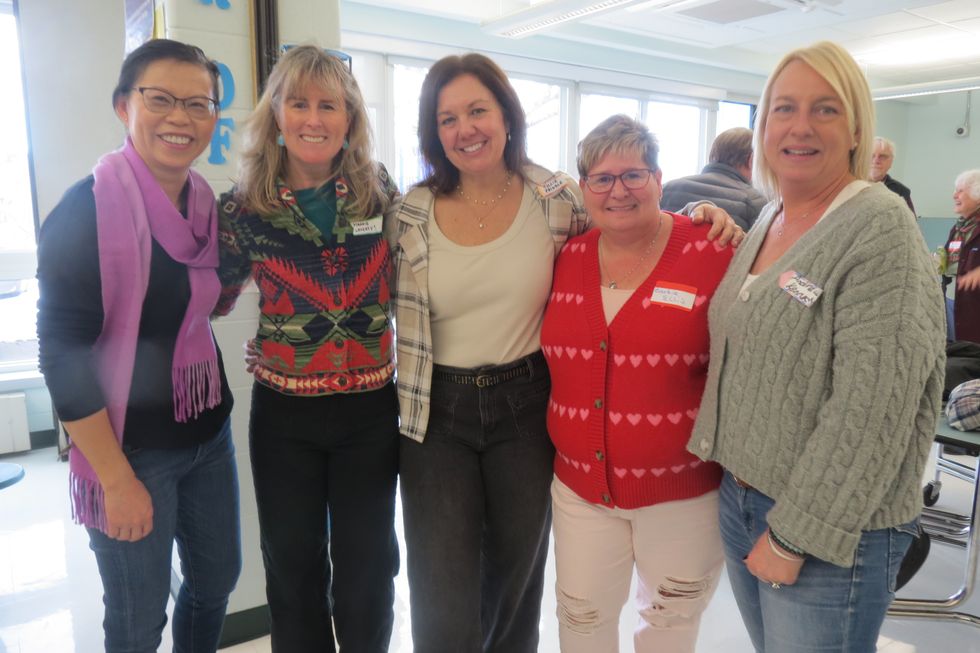
King remembered that Robbins had them read Garrison Keillor’s “Prairie Home Companion” and that he invited students to his home for sledding.
King, and others, recalled the wooden hand Comporesi kept in his office as a deterrent to poor behavior. Jesse Loucks of Salisbury also had vivid memories of that spoon that had one smashed finger. When he thought about it, he went over to question Comporesi to ask if that finger was a result of his using it to punish someone. He came back with the answer. “He said that broken finger was just for effect,” reported Loucks.
For Nam Kry of New York City, Sharon Center School played a pivotal role in his life. He and his family were from Cambodia and were sponsored to come to town by the Sharon Congregational Church. Knowing no English, he said sports was the way he broke through the language barrier and he credited the two teachers for providing those experiences. He and his siblings were the only Asian students at the school at that time, but they were embraced by the school and community.
Kry went off to Salisbury School, Yale for an undergraduate degree and Harvard for a master’s. He works in the area of technology. “My American dream started here,” he said. Robbins noted he was one of the brightest students he ever taught.
As she embraced Comporesi, Janette Ireland of Kent said, “He was tough. He didn’t let us get away with anything.” Ed Duntz of Sharon said his main remembrance about Robbins was telling the students they all needed to know about football, because the boys would play it and the girls would date players. Douglas Cahill, current chairman of the Sharon Center School Board of Education, said his greatest pleasure is giving out the Comporesi Sports Award for sportsmanship at each graduation and Brian Wilcox beamed to relate that his daughter Morgan received that award.
Several women from the classes of 1986 and 1987 attended, pleased to see the teachers and each other. Andrea Kennedy said the two “set expectations because they loved the kids that went here” and Maggie Laverty said they inspired her to become a teacher.
Jamie Hall Casey of Sharon said when her father died, Comporesi was the first to arrive for his calling hours. Linda Amerighi of Sharon remembers students having to take part in the Presidential Fitness program under Comporesi’s supervision, which gave students needed exercise. “I still have my badges and certificates,” she said, proudly.
Jonathan Costa, who is director of EdAdvance, said his father, Tony Costa, a former principal at the school, hired Comporesi. “Jack inspired me in sports and Irv inspired me in education,” said Costa.
Ellie Lowell of Sharon came to show her appreciation to them both, but said Robbins made her seventh- and eighth-grade years enjoyable after having a difficult sixth-grade experience. “You don’t forget teachers like that,” she said.
Wanda Moeller of Sharon was the school secretary from 1977 to 2006. “They were a lot of fun,” she said of the pair. “They cared deeply about their students.”
“I knew I’d enjoy it and I did,” said Robbins, looking around the room toward the end of the event. “It’s a dream come true. I loved the kids, most of whom I haven’t seen since they graduated. To see them as adults is a joy.”
The Torrington Transfer Station, where the Northwest Resource Recovery Authority plans to expand operations using a $350,000 state grant.
TORRINGTON — The Northwest Resource Recovery Authority, a public entity formed this year to preserve municipal control over trash and recycling services in northwest Connecticut, has been awarded $350,000 in grant funds to develop and expand its operations.
The funding comes from the Department of Energy and Environmental Protection via its Sustainable Materials Management grant program. It is intended to help the NRRA establish operations at the Torrington Transfer Station as well as support regional education, transportation, hauler registration and partnerships with other authorities.
Founded by the City of Torrington in May 2025, the NRRA was established to oversee regional municipal solid waste management. Its creation followed a $3.25 million offer by USA Waste & Recycling to purchase the Torrington Transfer Station — a sale that would have privatized trash services in the region.
The proposed sale was initially approved by the MIRA Dissolution Authority, the entity responsible for dissolving the state’s former Materials Innovation and Recycling Authority, which owned the Transfer Station at the time. Before the transaction could close, the state intervened and directed that the facility’s operating permit be assigned to the NRRA to preserve a publicly controlled alternative.
MIRA has since dissolved, and the Transfer Station is currently operated by the state Department of Administrative Services. Many towns in northwest Connecticut have expressed interest in joining the NRRA. As of December, Torrington and Goshen were the only two municipalities in the authority.
At the Dec. 11 meeting of the Northwest Hills Council of Governments (COG) — a regional planning body representing 21 municipalities in northwest Connecticut — Director of Community and Economic Development Rista Malanca encouraged more towns to sign on.
“We need towns to join the Northwest Resource Recovery Authority to show your support, show this is what you want to do,” Malanca said.
Salisbury First Selectman Curtis Rand said his municipality is planning a town meeting in January to vote on a resolution to join the NRRA. Cornwall’s Board of Selectmen recently discussed scheduling a town meeting in the winter for the same purpose. Sharon, Falls Village and North Canaan have also expressed continued interest in pursuing a public option.
Kent is the northernmost member of the Housatonic Resource Recovery Authority, a regional solid waste authority representing 14 municipalities stretching south to Ridgefield. COG towns expressed interest in joining HRRA in 2024, but they were denied and set out to develop the NRRA.
“We also have been having conversations with the Capital Region Council of Governments and the Naugatuck Valley Council of Governments to think about how we can use existing resources, maybe some of these grant funds, to bring in shared resources or shared staffing that will help with some of the recycling coordinating efforts,” Malanca said.
With grant funds secured, NRRA aims to grow to a point that it can take over operations at Torrington Transfer Station to serve as a regional hauling hub. What happens to the trash after that has yet to be determined. Currently, it is being shipped to a landfill out of state. The existing municipal refuse hauling contracts that were established with the state expire in 2027.
The Salisbury Winter Sports Association (SWSA) will host its annual Junior Jump Camp, a two-day introduction to ski jumping, on Saturday and Sunday, Dec. 27 and 28, from 9 a.m. to 2 p.m. at Satre Hill in Salisbury.
The camp is open to children ages 7 and up and focuses on teaching the basics of ski jumping, with an emphasis on safety, balance and control, using SWSA’s smallest hill. No prior experience is required.
The cost is $50 per child and includes instruction and lunch on both days. For more information or to register, visit www.skireg.com/swsa-camp or email info@jumpfest.org
Jesse Bunce, first selectman of North Canaan.
LITCHFIELD — The Northwest Hills Council of Governments welcomed six newly elected municipal leaders Thursday, Dec. 11, at its first meeting following the 2025 municipal elections.
The council — a regional planning body representing 21 towns in northwest Connecticut — coordinates transportation, emergency planning, housing, economic development and other shared municipal services.
Barkhamsted First Selectman Meaghan Cook, Goshen First Selectman Seth Breakell, Kent First Selectman Eric Epstein, Norfolk First Selectman Henry Tirrell, North Canaan First Selectman Jesse Bunce and Torrington Mayor Molly Spino were each elected to their post in November.
They filled the seats of their predecessors on the COG, who were each given a toast of appreciation: Nick Lukiwsky (Barkhamsted), Todd Carusillo (Goshen), Marty Lindenmeyer (Kent), Matt Riiska (Norfolk), Brian Ohler (North Canaan) and Elinor Carbone (Torrington).
COG Executive Director Rob Phillips said the outgoing members were given a going away mug that read “You’re living the dream still.” Members voted to appoint Warren First Selectman Greg LaCava to fill a vacancy on the Council’s Executive Committee. COG members voted by paper ballot, and LaCava defeated Burlington First Selectman Doug Thompson for the vacant seat.
Ryan Segalla takes a fadeaway shot over a defender.
FALLS VILLAGE — Housatonic Valley Regional High School’s boys basketball team defeated Pine Plains High School 60-22 in a scrimmage Tuesday, Dec. 9. The non-league preseason game gave both sides an opportunity to run the court ahead of the 2025-26 varsity season.
HVRHS’s senior-heavy roster played with power and poise. The boys pulled ahead early and kept their foot on the gas through to the end.
By halftime the score was 33-8. Junior varsity players subbed in for the second half, but not before the starters got some in-game dunk practice. By the end Housatonic totaled 60 points to Pine Plains’ 22.
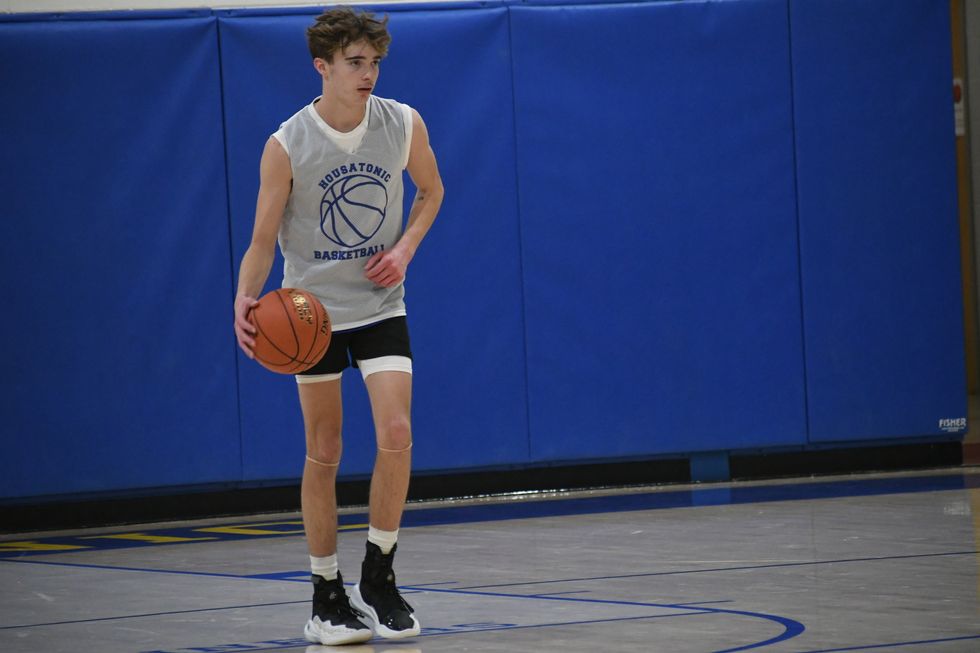
Nick Crodelle led the Mountaineers offensively with 13 points. Anthony Labbadia and Wyatt Bayer scored nine points each. Anthony Foley scored eight points. Owen Riemer and Ryan Segalla each scored seven points. Peyton Bushnell hit a three-pointer. Jaxon Visockis and Henry Berry each scored two points.
HVRHS begins Berkshire League competition on the road at Nonnewaug High School Tuesday, Dec. 16, with a 6 p.m. tip off.
